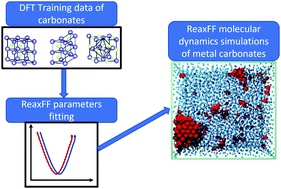Development and application of ReaxFF methodology for understanding the chemical dynamics of metal carbonates in aqueous solutions†
Abstract
A new ReaxFF reactive force field has been developed for metal carbonate systems including Na+, Ca2+, and Mg2+ cations and the CO32− anion. This force field is fully transferable with previous ReaxFF water and water/electrolyte descriptions. The Me–O–C (Me = metal) three-body valence angle parameters and Me–C non-reactive parameters of the force field have been optimized against quantum mechanical calculations including equations of state, heats of formation, heats of reaction, angle distortions and vibrational frequencies. The new metal carbonate force field has been validated using molecular dynamics simulations to study the solvation and reactivity of metal and carbonate ions in water at 300 K and 700 K. The coordination radius and self-diffusion coefficient show good consistency with existing experimental and simulation results. The angular distribution analysis explains the structural preference of carbonate ions to form carbonates and bicarbonates, where Na+ predominantly forms carbonates due to weaker angular strain, while Ca2+ and Mg2+ prefer to form bicarbonate monodentate in nature. Residence time distribution analyses on different systems reveal the role of ions in accelerating and decelerating the dynamics of water and carbonate ions under different thermodynamic conditions. The formation and dissolution of bicarbonates and carbonates in solution were explored on the basis of the protonation capability in different systems. The nucleation phenomenon of metal carbonates at ambient and supercritical conditions is explained from the perspective of cluster formation over time: Ca2+ ions can form prenucleation clusters at ambient temperature but show saturation with increasing temperature, whereas Na+ and Mg2+ ions show a rapid increase in cluster size and amount upon increasing time and temperature.



 Please wait while we load your content...
Please wait while we load your content...
